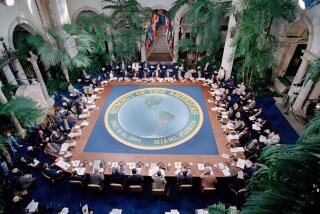Shades of Madison Avenue Seen in Summit Theme
- Share via
WASHINGTON — When President Reagan’s staff was preparing for his impending meetings in Moscow with Soviet leader Mikhail S. Gorbachev, they consulted with think tanks, with experts on the Soviet Union--and with about two dozen ordinary Americans in a Philadelphia suburb.
And what the President’s advisers gleaned from the rank-and-file citizenry has played a major role in how Reagan will handle himself and the themes he will emphasize in the tableau to be played out in Moscow.
In a sophisticated variation of a man-in-the-street survey, pollsters hired by the Republican National Committee huddled one evening last winter with a collection of blue-collar workers and professionals, homemakers and mothers of both parties.
What they learned fascinated Reagan’s summit team. Speaking with unusual candor about how the White House seeks to manipulate public reaction, a senior White House official who insisted on anonymity said:
“Americans were not well-informed there would be a summit--a high degree of unawareness--which gave us the opportunity to begin conditioning how it would be viewed. We looked at various ways we could characterize the summit that would not stretch people’s credibility and would build support for the summit.”
Working with the Philadelphia-area residents, the Republican pollsters tried out half a dozen possible themes for the first trip by an American President to Moscow in 14 years. The winner: “A brighter future and a safer world for all people.”
Whether Reagan will actually use precisely those words in Moscow remains unclear. Regardless, the theme will underlie much of what he does when he arrives in the Soviet capital Sunday.
Thus, a senior White House official said, his speech to students at Moscow State University on Tuesday will focus on the “safer world” that will result from the U.S.-Soviet treaty, signed at the summit last December in Washington, that bans ground-launched medium-range nuclear missiles.
Developing that message received all the care that Madison Avenue devotes to an advertising campaign for a new bar of soap.
First, senior officials analyzed the state of U.S.-Soviet relations. Then they brought in Richard Wirthlin, the Republican pollster, to determine how that relationship meshed with the public’s perceptions.
Testing Their Theories
And finally, they convened two “focus groups” in a Philadelphia suburb, which they declined to name, to test their theories with about 25 people described by one person familiar with the sessions as “a fairly good, representative cross-section by age, partisanship, male-female.”
“The focus groups confirmed our basic discussions and thoughts about how to position the message that’s coming out” of the summit, a senior White House official said.
Another White House official, also speaking on the condition of anonymity, added: “It helped us to design some of the events and who the President meets with.”
Although the discussion groups demonstrated that “the issue of war and peace” remained at the heart of public concerns about the U.S.-Soviet relationship, it also found that “people want to see more exchanges--people-to-people or student exchanges,” this official said.
The focus groups did not determine Reagan’s entire schedule, however. The official said the President’s planned visit to a restored monastery Monday is designed to play to his supporters back home.
“We’re doing some of these things on religious freedom because part of the President’s core of support is the conservative, right-wing religious groups,” he said.
White House officials said they took care to avoid placing Reagan in a public relations contest with Gorbachev, whose free-wheeling style and seemingly spontaneous visit with Americans on a downtown street corner during the Washington summit last December captivated many in the United States.
In the belief that Reagan’s personality comes across best in structured settings, they have arranged events similar to those he attends at home: meetings with small groups and scripted speeches to large groups, often on campuses.
To encourage candid exchanges, White House officials said, most of the sessions will take part on the “home turf” of the groups with which Reagan is meeting--students at the university; poets, artists, film makers and other cultural figures at an aging brownstone operated by the Writers’ Union, and religious figures at the monastery.
The U.S. Embassy, one official said, would merely intimidate the Soviets with whom Reagan will meet.
More to Read
Get the L.A. Times Politics newsletter
Deeply reported insights into legislation, politics and policy from Sacramento, Washington and beyond. In your inbox twice per week.
You may occasionally receive promotional content from the Los Angeles Times.










